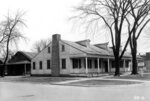

GREEN BAY – After the War of 1812, American emigrants settling the country needed to protect their territory from those wishing to claim or re-claim the land and its bounty.
As they pushed westward to capture the fur trade, a chain of government forts sprung up in the western Great Lakes region to protect the river routes and the settlers who were staking their claim.
In 1816, Fort Howard was established on the western bank of the Fox River below the bay of Green Bay.
The fort linked Fort Niagara in New York and Fort Detroit in Michigan with Fort Winnebago in Portage, Fort Crawford in Prairie du Chien and Fort Snelling in St. Paul, Minn.
The fort would become an integral site for trade, due to its location, and a passageway for westward expansion.
A letter from Captain of Rifles John O’Fallon to General Duncan McArthur, dated Sept. 24, 1816, chronicled the selection of the site for the fort.
“After looking for some days for a proper site, [Major Charles Gratiot] has finally fixed on the position where the old French fort formerly stood. It will be a stockade with strong pickets, a bastion at each angle, with a piece of artillery on each, amply sufficient to beat off any [Native American] force that can be brought against it,” he wrote.
“The fort is situated about one mile up the river and half mile below where commences a mongrel French settlement that extends about five miles on both sides of the river and is occupied by about 40 families…
The government allocated $21,000 for the fort’s construction and it was christened Fort Howard in honor of Gen. Benjamin Howard.
By 1819, the personnel at Fort Howard totaled 554 soldiers.
In 1820, H.R. Schoolcraft visited the fort, writing in his journal, “It consists of a range of log barracks, facing three sides of a square parade, and surrounded by a stockade of timber, 30 feet high, with blockhouses at the angles. The whole is whitewashed, and presence a neat military appearance.
When Colonel Joseph Lee Smith assumed command of the fort, he moved it to higher ground — a place that would serve as a better vantage point, or lookout.
A stockade was created across the river in 1820 and named “Camp Smith” —on land that is now located inside Heritage Hill State Historical Park.
Green Bay’s Heritage Hill remains a keeper of that history, with several preserved buildings and other reconstructions that hold the story of Fort Howard.
Fort Howard Guard House
Originally built by the U.S. Army in 1833-1835 and relocated to Heritage Hill in 2010.
This original Fort Howard building was constructed on the west bank of the Fox River.
Fort Howard Hospital
Originally built by the U.S. Army outside the fort’s perimeter; it was relocated to Heritage Hill in 1975.
The hospital is listed on the National Register of Historic Places.
Fort Howard Officers’ Quarters
A reproduction was built in 1982 at Heritage Hill.
Fort Howard Post School
A reproduction was built in 1982 at Heritage Hill.
Company Kitchen/Orderly Room
The structure was built by the U.S. Army Fifth Infantry Regiment in 1835 and relocated to Heritage Hill.
The building is listed on the National Register of Historic Places.
For more information, visit https://heritagehillgb.org.